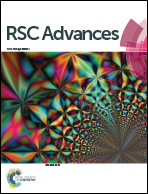Si doped highly crystalline mesoporous In2O3 nanowires: synthesis, characterization and ultra-high response to NOx at room temperature†
Abstract
1D highly crystalline mesoporous In2O3 nanowires (INWs) coated by an amorphous silica (HCMIAS) ultrathin surface layer were successfully fabricated using SBA-16 as a hard template. Various techniques, including XRD, SEM, TEM and X-ray photoelectron spectroscopy (XPS), were employed for material characterization. All the results demonstrated that the obtained INW-2 sample, which contained 15 at% SiO2 and 85 at% In2O3 in 0.2 M In(NO3)3 solution, displayed high crystallinity with a rough surface coating layer of SiO2 in the atomic scale. The domain diameter of INW-2 was approximately 4–8 nm with the pore size of 3–5 nm. The NOx sensing properties of the INW-2 sensor exhibited an ultra-high response and selectivity with the low detection limit of 0.97 ppm and high response of 115.6 to 97.0 ppm NOx at RT. The excellent gas sensing property of the 1D morphology with amorphous silica was associated with its higher surface area and space-charge layer, which induced highly effective surface interactions between the target gas molecules and the surface active sites. Moreover, the synergetic and electronic effect on INW-2 favored the effective adsorption of NOx on the surface. All the factors considered had evident beneficial effects on enhancing the gas sensing performance of the sensor.


 Please wait while we load your content...
Please wait while we load your content...